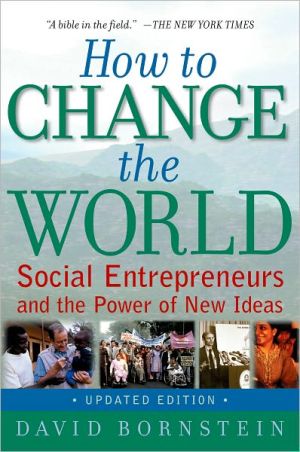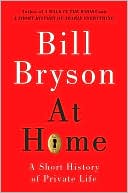How to Change the World: Social Entrepreneurs and the Power of New Ideas
Now published in more than twenty countries, David Bornstein's How to Change the World has become the bible for social entrepreneurship--in which men and women around the world are finding innovative solutions to a wide variety of social and economic problems. Whether delivering solar energy to Brazilian villagers, expanding work opportunities for disabled people across India, creating a network of home-care agencies to serve poor people with AIDS in South Africa, or bridging the...
Search in google:
"Social entrepreneurs" are to social change what business entrepreneurs are to the economy. Aimed at the general reader, this text presents inspiring accounts of dozens of individuals around the world who have stepped in to solve problems where governments and bureaucracies have failed. For example, one of the innovators profiled is a South African woman who developed a home-based care model for AIDS patients that changed government health policy. Another chapter tells the story of an American man credited with saving 25 million lives by marketing a global campaign for immunization. Annotation ©2004 Book News, Inc., Portland, OR Publishers Weekly Journalist Bornstein (The Price of a Dream: The Story of the Grameen Bank) profiles nine indomitable champions of social change who developed innovative ways to address needs they saw around them in places as distinct as Bombay, India; Rio de Janeiro, Brazil; and inner-city Washington, D.C. As these nine grew influential when their ingenious ideas proved ever more widely successful, they came to the attention of Ashoka, an organization that sponsors a fellows program to foster social innovation by finding so-called social entrepreneurs to support. As Bornstein interviewed these and many other Ashoka fellows, he saw patterns in the ways they fought to solve their specifically local problems. To demonstrate the commonality among experiences as diverse as a Hungarian mother striving to provide a fuller life for her handicapped son and a South African nurse starting a home-care system for AIDS patients, he presents useful unifying summaries of four practices of innovative organizations and six qualities of successful social entrepreneurs. Bornstein implies that his subjects are in the tradition of Florence Nightingale and Gandhi; the inspiring portraits that emerge from his in-depth reporting on the environments in which individual programs evolved (whether in politically teeming India or amid the expansive grasslands of Brazil) certainly show these unstoppable entrepreneurs as extraordinarily savvy community development experts. In adding up the vast number of current nongovernmental organizations and their corps of agents of positive change, Bornstein aims to persuade that, without a doubt, the past twenty years has produced more social entrepreneurs than terrorists. Copyright 2003 Reed Business Information.
Excerpted from Chapter 1\ Restless People\ The Emergence of the Global Citizen Sector\ Social entrepreneurs have existed throughout history. St. Francis of Assisi, the founder of the Franciscan Order, would qualify as a social entrepreneur -- having built multiple organizations that advanced pattern changes in his "field." Similarly, Florence Nightingale created the first professional school for nurses and established standards for hygiene and hospital care that have shaped norms worldwide. What is different today is that social entrepreneurship is developing into a mainstream vocation, not only in the United States, Canada, and Europe, but increasingly in Asia, Africa, and Latin America. In fact, the rise of social entrepreneurship represents the leading edge of a remarkable development that has occurred across the world over the past three decades: the emergence of millions of new citizen organizations.\ Consider that twenty years ago Indonesia had only one independent environmental organization. Today it has more than 2,000. In Bangladesh, most of the country's development work is handled by 20,000 NGOs; almost all them were established in the past twenty-five years. India has well over a million citizen organizations. Between 1988 and 1995, 100,000 citizen groups opened shop in the former communist countries of Central Europe. In Canada, the number of registered citizen groups has grown by more than 50 percent since 1987, reaching close to 200,000. In Brazil, in the 1990s, the number of registered citizen organizations jumped from 250,000 to 400,000, a 60 percent increase. In the United States, between 1989 and 1998, the number of public service groups registered with the Internal Revenue Service jumped from 464,000 to 734,000, also a 60 percent increase. Given the long history of citizen activity in the United States, it comes as a surprise that 70 percent of registered groups are less than thirty years old. And during the 1990s, the number of registered international citizen organizations increased from 6,000 to 26,000.\ Historically, these organizations have been defined in the negative -- as nonprofit or nongovernmental organizations. Today they are understood to comprise a new "sector," variously dubbed the "independent sector," "nonprofit sector," "third sector," or, the term favored in this book, the "citizen sector." Hundreds of universities in the United States, including Harvard, Stanford, Yale, Duke and Johns Hopkins, have established college courses and centers to study this sector. A Johns Hopkins study of eight developed countries found that, between 1990 and 1995, employment in this sector grew two and a half times faster than for the overall economy. Peter Drucker, the management expert, has called this sector America's leading growth industry.\ Although public service organizations are far from new, this worldwide mobilization of citizens is new in several respects:\ (1) It is occurring on a scale never before seen;\ (2) The organizations are more globally dispersed and diverse than in the past;\ (3) Increasingly, we find organizations moving beyond stop-gap solutions to more systemic approaches to problems -- offering better recipes, not just more cooking;\ (4) Social entrepreneurs are less encumbered by church and state and, in fact, exert considerable pressure on governments (as witnessed in the International Campaign to Ban Landmines and the creation of the International Criminal Court);\ (5) They are forging partnerships with businesses, academic institutions, and governments -- and, in many cases, refining the government's representational function; and;\ (6) Because of the natural jostling for position that occurs when a formerly restricted sector suddenly enjoys "open entry" and new players crowd onto the field, the citizen sector is experiencing the beneficial effects of entrepreneurialism, increased competition and collaboration, and a heightened attention to performance.\ Despite their magnitude, these changes have gone largely unreported. Almost everyone knows about the explosion of the dot-coms -- a much smaller phenomenon -- but millions have still not heard the big story: the worldwide explosion of dot-orgs. It is a story with far-reaching implications: By sharpening the role of government, shifting practices and attitudes in business and opening up waves of opportunity for people to apply their talents in new, positive ways, the emerging citizen sector is reorganizing the way the work of society gets done.\ Excerpted from Chapter 13\ J.B. Schramm, USA, College Access\ The Talent Is Out There\ In the late 1980s, while attending Harvard Divinity School, Jacob ("J.B.") Schramm first recognized the college "market gap." To pay his way through graduate school, Schramm had taken a job as an academic advisor to freshmen. Each year he had to review the admissions files of thirty newly enrolled students. Reading through the applications from low-income students, he frequently came across handwritten notes in the margins: "Wish we could find ten more like him!"\ After graduating from divinity school, Schramm, then twenty-eight, moved to Washington, D.C., where, in 1991, he became the director of the teen center at the Jubilee Housing Development. There he saw the college "market gap" from the other end of the pipe. The students with top grades and test scores were zipping off to college. Ivy League schools sought them out. But the vast majority of the kids Schramm worked with had average grades and test scores, and colleges paid little attention to them.\ There was a reason. Colleges have systems to identify low-income "stars." They buy lists from the College Board and compete for the top students. All communities launch their academic stars, but only the middle- and upper-income brackets regularly launch their "mid-tier" performers.\ The seniors in the teen center all told Schramm, "Yeah, sure, I'm going to college." But two months after high school ended, he would find many of them hanging out on the street. "A year later, their eyes were dulled," he said.\ What went wrong?\ "Absolutely mundane things," recalls Schramm. "I'd hear: 'I sent the application incomplete and never heard back. I only applied to two schools and didn't get in.'" Schramm discovered that most of these students' parents had not attended college themselves. They had difficulty guiding their children through the application process. And many of the students didn't really believe that they were "college material."\ But Schramm saw them differently. "The kids who had middling scores had other things going on," he recalled. "One had written a screenplay. Others took care of brothers and sisters. Some were outstanding artists. Or one day there would be a fight, and I'd see a kid do something wise and courageous. Then I'd see the application and know there's no way the college is going to know about this kid's grit and moxie. But if you saw the kid handle challenges in the teen center, it was crystal clear. For me that was the 'aha!' moment. The challenge was to get the colleges to see these kids as I saw them. Because many were better than their numbers suggested."\ In 1993 four students -- Theresa, Desmond, Yonday, and Alimamy -- approached Schramm asking for help getting into college. They were smart kids with lots of ability, but their grades and Scholastic Aptitude Test (SAT) scores were average. How to convey their potential? Schramm believed that a heartfelt essay could make a difference. "I had faith that if people told a part of their story that was important to them, it would convey their strengths to another human being in a way that nothing else could," he said.\ He called Keith Frome, his closest friend from divinity school, who had taught expository writing to freshmen at Harvard, and asked him to come down from New York to Washington for a weekend to help the students write essays that would "jump off the desk." "Keith was the best writing teacher I had ever seen," recalled Schramm.\ On the Amtrak train, Frome designed a curriculum based on writing theories he'd studied at Harvard. It would begin with ten minutes of unstructured "free writing," in which students would be encouraged to scribble random thoughts without editing themselves. Afterward, they would read the pieces aloud while the other students took note of images and phrases that stuck in their minds. Frome called this process "gold mining." Everyone's comments would be written on charts taped to the walls, a process that would both validate the students' thoughts and help them identify guiding ideas for their essays. Then the main job would be to remind the students to show what they mean, not just to tell it.\ When Frome arrived in Washington, he and Schramm ran out to buy pencils, markers, butcher block paper, and masking tape. By late Sunday the students had first drafts of their college admission essays.\ Then Schramm called up Derek Canty, a youth motivator whom he had met on a Flyers' excursion to Colorado, and invited him to Washington to conduct a motivational "rap session" for the students. Schramm wanted to help them identify personal obstacles that might derail their college plans. "Derek was without question the best youth facilitator I'd ever seen," he recalled.\ In the months that followed, one student enrolled in Brown University, one went to Montgomery County Community College, and the other two received full scholarships to Connecticut College, a liberal arts school in New London. Lee Coffin, who was then dean of admissions at Connecticut College, recalled: "Most college applications from low-income students fail to provide a good picture of the kid. The essays are flat. The recommendation letters consist of a single paragraph or even just a sentence. We're asking ourselves: 'If we accept the kid, can he succeed?' We're looking to predict the future. So when the kid doesn't have the numbers, you need something else to hang on to. And these kids told evocative stories that gave a vivid sense that they were succeeding against the odds."\ In 1994 four more students went through the same process. All four were also admitted to colleges. "The difference between someone who is an entrepreneur and someone who isn't," explained Frome, "is that I went back to my job, but J.B. knew that we had invented something unique. He saw it. And he refined it and bottled it."\ * * *\ By August 2002 nearly 4,000 students had passed through the program that Schramm had created: College Summit. Ninety-five percent were minorities: 50 percent African American, 35 percent Latino, and 10 percent Native American. The average grade point average (GPA) was 2.8. College Summit reports that, between 1993 and 2002, the college enrollment rate for high school graduates who attended its workshops was 79 percent; retention was 80 percent. According to the U.S. Census, the national enrollment figure for high school graduates at similar income levels is 46 percent. (There are no national data on college retention rates.)\ In addition to the intangible gains, college graduates can expect to earn $1 million more during their working years than high school graduates and contribute $300,000 more in taxes. In first-generation college families, graduates generally establish new patterns of achievement that carry forward in siblings, cousins, and children. Says Schramm: "That young man who is the first in his family to get a college degree has basically ended poverty in his family line forever."\ Copyright © 2004 David Bornstein
Acknowledgments1Restless People12From Little Acorns Do Great Trees Grow113The Light in My Head Went On: Fabio Rosa, Brazil: Rural Electrification204The Fixed Determination of an Indomitable Will: Florence Nightingale, England: Nursing405A Very Significant Force: Bill Drayton, United States: The Bubble476Why Was I Never Told about This?617Ten - Nine - Eight - Childline!: Jeroo Billimoria, India: Child Protection688The Role of the Social Entrepreneur909"What Sort of a Mother Are You?": Erzsebet Szekeres, Hungary: Assisted Living for the Disabled9810Are They Possessed, Really Possessed, by an Idea?11711If the World Is to Be Put in Order: Vera Cordeiro, Brazil: Reforming Healthcare12612In Search of Social Excellence14613The Talent Is Out There: J. B. Schramm, United States: College Access15914New Opportunities, New Challenges17815Something Needed to Be Done: Veronica Khosa, South Africa: Care for AIDS Patients18316Four Practices of Innovative Organizations20017This Country Has to Change: Javed Abidi, India: Disability Rights20918Six Qualities of Successful Social Entrepreneurs23319Morality Must March with Capacity: James Grant, United States: The Child Survival Revolution24220Blueprint Copying25621Conclusion: The Emergence of the Citizen Sector264Epilogue280Notes283Resource Guide303Selected Readings309Index313
\ From the Publisher"Wonderfully hopeful and enlightening.... The stories of these social entrepreneurs will inspire and encourage many people who seek to build a better world." --Nelson Mandela\ "The book is must reading for anyone who cares about building a more equitable, and therefore more stable, world."--William J. Holstein, New York Times\ "I've told everyone within earshot about it. Besides, I'm confident that those who've read the earlier volume will appreciate the update...Buy extra copies of the book as gifts-someone you know may be looking for a future with meaning."--Portland Alliance\ "David Bornstein's How to Change the World provides a wonderful introduction to social entrepreneurship. It is engaging, inspiring, and informative, weaving Bornstein's thoughtful commentary with a set of rich, diverse, and instructive examples. It is the first book I recommend to interested students." -- Professor J. Gregory Dees, Faculty Director, Center for the Advancement of Social Entrepreneurship, Duke University's Fuqua School of Business\ "A fascinating book.... Well-documented cases of grassroots entrepreneurial activities to tackle such diverse social problems as child abuse, disability, illiteracy, and environmental degradation give life to it." --Laura D'Andrea Tyson, Business Week\ "This pioneering book details the development of social entrepreneurship globally with useful case studies and thoughtful analysis throughout. It represents one of the core teaching materials we use at Oxford."--Dr Alex Nicholls, Lecturer in Social Entrepreneurship, Said Business School, Oxford University\ "One of the most powerful transformative forces in this century is social entrepreneurship and this book insightfully probes these entrepreneurial change agents driving this process. Enriching reading for students and practitioners seeking to build a better world."--James E. Austin, Snider Professor of Business Administration, Emeritus, and Co-Founder of the Harvard Business School Social Enterprise Initiative\ \ \ \ \ \ Publishers WeeklyJournalist Bornstein (The Price of a Dream: The Story of the Grameen Bank) profiles nine indomitable champions of social change who developed innovative ways to address needs they saw around them in places as distinct as Bombay, India; Rio de Janeiro, Brazil; and inner-city Washington, D.C. As these nine grew influential when their ingenious ideas proved ever more widely successful, they came to the attention of Ashoka, an organization that sponsors a fellows program to foster social innovation by finding so-called social entrepreneurs to support. As Bornstein interviewed these and many other Ashoka fellows, he saw patterns in the ways they fought to solve their specifically local problems. To demonstrate the commonality among experiences as diverse as a Hungarian mother striving to provide a fuller life for her handicapped son and a South African nurse starting a home-care system for AIDS patients, he presents useful unifying summaries of four practices of innovative organizations and six qualities of successful social entrepreneurs. Bornstein implies that his subjects are in the tradition of Florence Nightingale and Gandhi; the inspiring portraits that emerge from his in-depth reporting on the environments in which individual programs evolved (whether in politically teeming India or amid the expansive grasslands of Brazil) certainly show these unstoppable entrepreneurs as extraordinarily savvy community development experts. In adding up the vast number of current nongovernmental organizations and their corps of agents of positive change, Bornstein aims to persuade that, without a doubt, the past twenty years has produced more social entrepreneurs than terrorists. Copyright 2003 Reed Business Information.\ \ \ Soundview Executive Book SummariesSocial Entrepreneurs and The Power of New Ideas\ According to journalist David Bornstein, social entrepreneurs are people with powerful ideas to improve other people's lives who have implemented these ideas across cities, countries and, in some cases, the world. These are the doctors, lawyers, engineers, teachers, journalists and parents who solve social problems on a large scale and have a profound effect on society. Bornstein points out that they are usually not famous, and are usually not politicians. They are the people who create a transformative force that addresses major problems in the pursuit of a vision, and they will not give up until they have spread their ideas as far as possible. \ How to Change the World provides a close look at numerous people from several countries - including the United States, Brazil, Burkina Faso, Hungary, India and Bangladesh - who have advanced systemic change and shifted behavior patterns and perceptions. They have ideas for attacking problems, Bornstein points out, and are unwilling to rest until they have spread their ideas throughout society.\ Solving Challenging Problems\ Bornstein has chronicled the achievements of many of these people in solving problems that challenge all societies around the globe: inadequate education and health systems, environmental threats, declining trust in political institutions, entrenched poverty, high crime rates, etc. He also demonstrates how their ideas can help businesspeople and nonprofit managers see how social entrepreneurs have served large "markets" with limited resources to solve problems and make a positive change. The creative people Bornstein describes possess the determination and will to propel the innovation that society needs to tackle its toughest problems. He points out that these lessons can be applied across all types of organizations and industries.\ Bornstein also describes the recent growth of what he calls the "citizen" sector - the nonprofit and nongovernmental organizations that make up the framework of the social and economic supports, thus multiplying the number and the effectiveness of the world's social entrepreneurs. According to business guru Peter Drucker, this sector is America's leading growth industry.\ Bornstein explains that by "sharpening the role of government, shifting practices and attitudes in business and opening up waves of opportunity for people to apply their talents in new, positive ways, the emerging citizen sector is reorganizing the way the work of society gets done."\ One of the social entrepreneurs Bornstein profiles is Gloria de Souza, a 45-year-old elementary school teacher in Bombay whose dream in 1981 was to transform education across India. Over her 20 years of teaching experience, she was pained by the rote learning taking place in her school that she felt was holding back her students. By adapting her teaching ideas to India's specific circumstances and founding an organization to build a team to spread her ideas -with the help of a stipend from the social entrepreneur organization Ashoka - she was able to disseminate her Environmental Studies (EVS) approach to teaching. In just a few years, she could demonstrate that her approach significantly increased students' performance. "By the end of the 1980s," Bornstein reports, "the Indian government had incorporated EVS into its national curriculum, making it India's official standard of instruction in grades one through three."\ Bornstein also describes - through the example of Muhammad Yunus of the Grameen Bank - how a social entrepreneur can innovate better ways to alleviate poverty among a group of people. Yunus attacked this challenge by focusing on access to capital. By creating a way for villagers to access small amounts of working capital, they are able to purchase assets, increase their productive capacity, and capture profits that usually go to moneylenders and land owners.\ Disability Rights\ Bornstein also highlights Justin Dart, a Texas Republican who had contracted polio in 1948 when he was 18 years old, and been denied a teaching certificate because he used a wheelchair. After visiting a facility in South Vietnam in 1967 for children with polio and witnessing the deplorable conditions there, he returned to the United States and became a spokesman for disability rights. He would eventually become a member of the National Council on the Handicapped during the presidency of Ronald Reagan, and worked to advance the first version of the Americans with Disabilities Act. In 1990, as chairman of the President's Committee on Employment of People with Disabilities, he fought to achieve the law's passage.\ Bornstein shows readers how inspired individuals can use determination and innovation to make a difference.\ Why We Like This Book\ How to Change the World reveals fascinating stories about remarkably creative people who have been able to challenge the status quo and facilitate positive change for others. Any organization can use these stories that address many of the most difficult issues facing people today to gain inspiration to solve problems where others have failed. Copyright © 2004 Soundview Executive Book Summaries\ \ \








